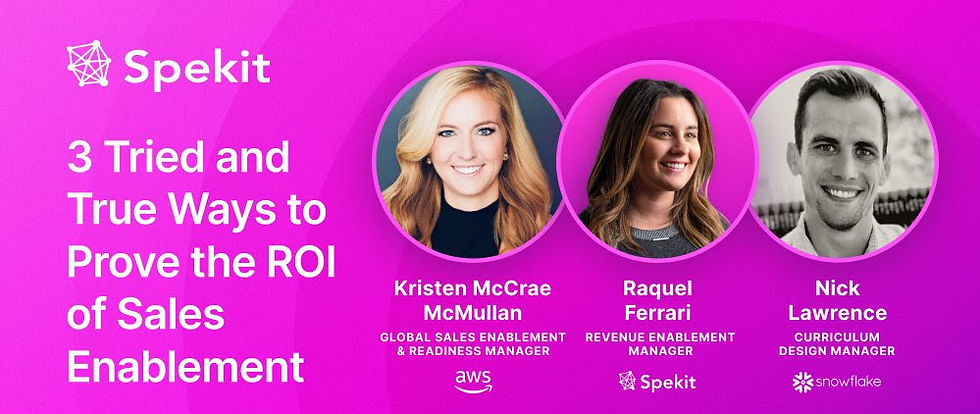Webinar Recap: Three Tried and True Ways to Prove the ROI of Sales Enablement
- Whitney Sieck, CPTD

- Sep 22, 2022
- 3 min read

On September 22, 2022 - I attended the webinar “Three Tried and True Ways to Prove the ROI of Sales Enablement“ sponsored by Spekit. What was unique about this webinar is that it wasn’t just another panel discussion - it included deep dives into case studies from both Kristen and Nick that revealed tactical frameworks that could be immediately applied on the job.
Here are some of the key takeaways:
Clarify sellers competencies and desired behaviors
Alignment with leadership is crucial; speak their language
Quantify what you can, prioritizing leading indicators
One of my favorite frameworks from Nick’s scenario was his PRIME framework to ensure your program is designed to support he execution of each behavior change required. We talk a lot about how important change management is in our function and how “starting with the why” is critical to change hearts and minds. But that’s all thought leadership fluff until we lift the veil on HOW to do these things. Nick provided a tactical framework for reflection to ensure the change is ready to be operationalized and communicated thoroughly. Do not pass go and do not collect $200 until you can say YES in response to the following questions:
P - Are they PREPARED to do it? (Knowledge)
R - Are they READY to do it? (Skills)
I - Are they INSPIRED to do it? (Motivation)
M - Do they have the MEANS to do it? (Environment)
E - Are you ENSURING they do it? (Measurement & Communication)
In Kristen’s scenario, she explored how to justify additional investments like a new enablement tool, external vendor training or headcount. She mentioned that you have to start by deeply considering your “roots” in the organization and assessing current state value. She provided the following questions to consider when defining your department’s roots:
What stage of maturity is the enablement team in?
Consider if your team is ready to take on the investment and maintain the current established workflows.
How is that aligned to audience maturity?
Even if Enablement is ready, determine if the audience ready for this investment or would the changes to their workflows be too disruptive. The pain of the current state problem you are trying to solve with the investment must be greater than the pain of change that will inevitably occur with implementation of the new tool or program.
What do you really need tomorrow?
Kristen talked about the importance of providing options to executives and outlining the benefits and risks and dependencies for each.
How can your investment align to the business and leadership business in place?
Make sure you are in the know on the Executive OKRs and what is being discussed at the board level. If you can align your investment to a top priority, you will be more likely to gain support.
What is the existing “love language” that you’ve identified within the organization?
When Kristen referred to “love language“ within a business, she’s talking about the buzz words that are common within the culture. Speaking the same language are your potential executive sponsors and stakeholders will help them feel more aligned and make it easier to connect the dots without arguing semantics.
If you want to catch the replay; it’s posted here for your viewing pleasure. In the recap email, they shared access to the templates that were discussed and ancillary blog posts related to the topic. I’d recommend that you follow Nick Lawrence on LinkedIn for his regular posts on learning and enablement models/frameworks (or check out his 🔆 Community Spotlight 🔆 here). Kristen is also one to watch - she is a leader for WiSE (Women in Sales Enablement) and has a really helpful article she posted on micro-KPIs (check it out here).
I loved your recap of this webinar! It’s so impactful when you can get some directly applicable skills like Nick’s PRIME framework or Kristen’s questions for evaluating additional investments. Thank you for this post!